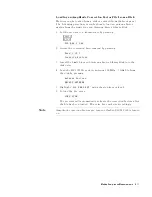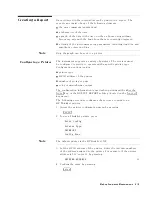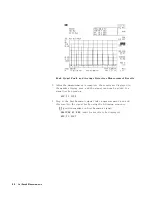
Note
The
measure-at-marker
function
uses
an
algorithm
to
sequentially
reduce
the
frequency
span
until
the
peak
of
the
signal
of
interest
is
displayed.
After
each
span
reduction,
the
marker
moves
to
the
largest
signal
present
on
the
display
.
The
receiver
indicates
which
signal
it
measured
by
leaving
the
marker
at
that
signal.
If
you
are
measuring
a
small
signal
in
the
presence
of
a
large
signal
the
algorithm
may
measure
the
larger
signal.
If
this
situation
occurs
,
reduce
the
span
until
the
larger
signal
is
one
major
frequency
division
away
from
the
smaller
signal.
If
using
the
Measure
at
Marker
function
to
measure
a
pulsed
signal
with
a
repetition
frequency
of
less
than
5
Hz,
set
the
sweep
time
to
greater
than
or
equal
to
the
inverse
of
the
pulse
repetition
frequency
.
(F
or
example
,
to
measure
a
1
Hz
CISPR
pulse
,
set
the
sweep
time
to
1
second
or
greater
prior
to
using
the
Measure
at
Marker
function.)
Strong
adjacent
signals
can
aect
measurement
accuracy
.
The
measure-at-marker
algorithm
detects
when
these
signals
may
be
interfering
with
the
measurement
and
displays
the
message
,
\Strong
adjacent
signal "
in
the
lower
left-hand
corner
of
the
display
.
The
eects
of
strong
signals
can
be
reduced
by
increasing
the
input
attenuation,
or
,
when
making
diagnostic
measurments
,
by
reducing
the
IF
bandwidth.
3-18
Making
Compliance
Measurements
Содержание 85422E
Страница 14: ...7 13 Using 3rd Ord Meas Function 7 19 12 1 External Keyboard Template 12 8 Contents 7 ...
Страница 61: ......
Страница 81: ......
Страница 116: ...Figure 6 25 Using Linearity Check to Identify Distortion Products Making EMI Diagnostic Measurements 6 35 ...
Страница 137: ......
Страница 161: ......
Страница 183: ......
Страница 195: ......
Страница 210: ...If nonrecoverable system errors occur regularly contact your HP representative Error Messages 13 15 ...
Страница 211: ......
Страница 218: ...Customer Support 14 7 ...
Страница 219: ......
Страница 229: ......
















































